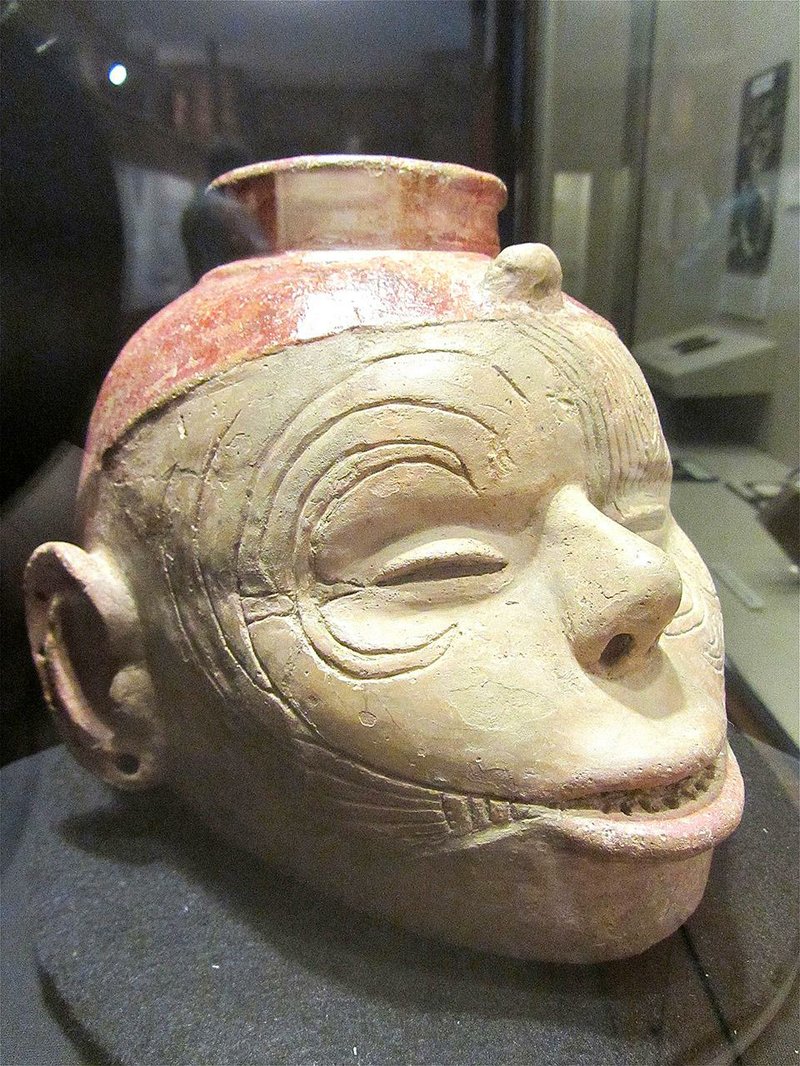WILSON -- Much mystery lurks in the beguiling centerpiece of Hampson Archeological Museum State Park, tucked on the edge of Tudor-tinged Wilson in northeast Arkansas.
The object is an American Indian effigy-head vessel dating to the middle of the 16th century. It stands out by portraying an actual person rather than an abstract image typical of the area's Late Mississippian culture that vanished before the coming of Europeans.
Two better-known state parks, Toltec Mounds and Parkin, also preserve and interpret aspects of Arkansas prehistory. But Hampson, despite the drab exterior of its 1,800-square-foot building, gives a particularly vivid sense of long-ago Natural State residents.
Hampson's showcase effigy-head vessel would merit a place of pride at a museum in New York or any other metropolis. At Hampson, its remarkable provenance is described in a brochure written by Tess Ann Pruett, the park's superintendent.
Pruett or another staff member is happy to show visitors around the exhibits. The detailed information in the brochure also provides copious background on the 15-acre palisaded village known as the Upper Nodena Cultural Site, source of the museum's artifacts.
The prize vessel "is believed to represent a person of high status such as a political or religious leader, renowned warrior, deceased revered ancestor, or a war trophy, as it is believed decapitation of an enemy was common. The artwork depicting a hawk and bird claw around the eyes, combined with the shape of a long horn on the back of the head, references the mythological hero Red Horn.
Nodena is the name of the plantation that belonged to James K. Hampson, an avid archaeological amateur who began study of the prehistoric site in 1927. Later excavations were conducted by the University of Arkansas and the Alabama Museum of Natural History.
At the site, a ceremonial plaza separated two mounds. South of the plaza was possibly a playing field for a game called chunky. The Nodena residents from about 1400 to 1650 grew corn, beans and squash. They hunted to provide food as well as skins for clothing and bones for tools and jewelry.
In the absence of a written language, these American Indians left only elusive clues about their lives -- mysterious enough that it's only a guess whether the fabulous effigy head portrayed a village chief or a beheaded enemy.
The present settlement of Wilson, graced by groves of cottonwood trees, was founded as a company town for lumbering in the 1880s and owned by family heirs until 2010. Its distinctive Tudor facades were ordered by a Wilson bridegroom in the 1920s after a honeymoon trip to England.
As reported earlier this year in The New York Times, new owner Gaylon Lawrence Jr. has ambitious plans to make the town of 905 a center of art, culture and education in the Delta.
Visitors can already savor the reopening of the Wilson Cafe under the aegis of young chef Joe Cartwright from the popular Elegant Farmer restaurant in nearby Memphis. One of his novel dishes is doughnut bread pudding.
In the offing is a new museum building about 10 times larger than the present Hampson facility. To be erected near the town square, with financial help from the state, it will allow the museum to display a host of Nodena Culture artifacts now in storage for lack of space. More mysteries will be posed.
Hampson Archeological Museum State Park, on the north edge of Wilson at U.S. 61 and Lake Drive, is open 8 a.m.-5 p.m. Tuesday-Saturday, 1-5 p.m. Sunday. Admission is free. Call (870) 655-8622 or visit arkansasstateparks.com.
Weekend on 10/30/2014
